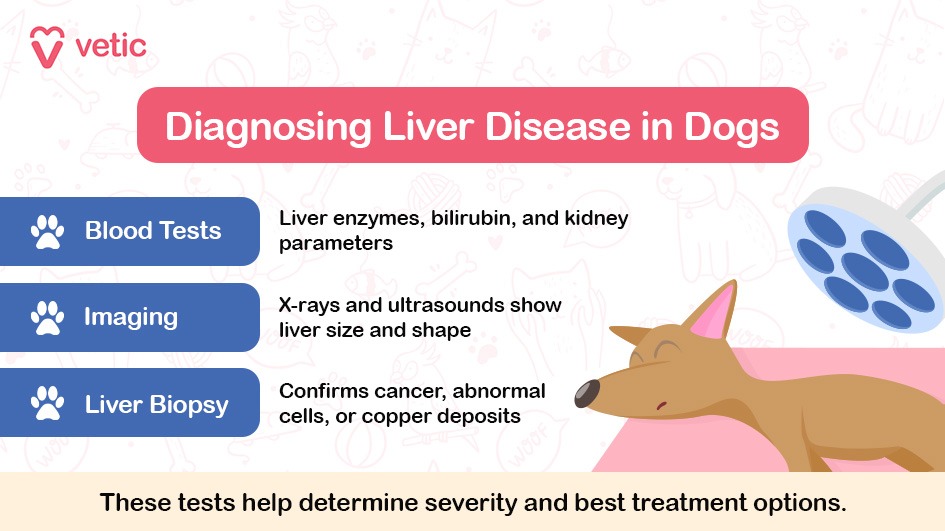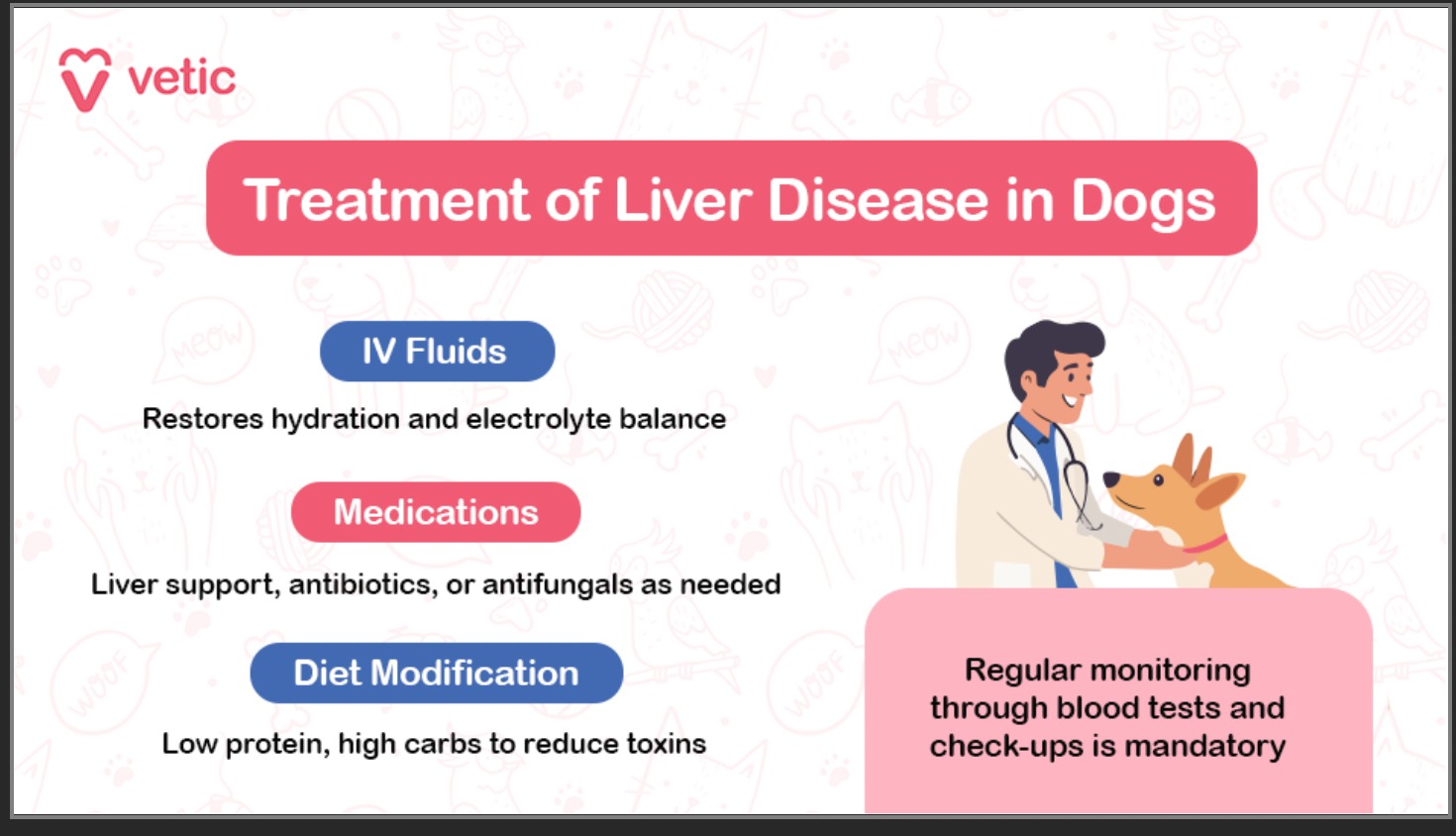Liver disease in dogs is not talked about enough! Did you know? Dogs aged 8 years and above are especially susceptible to liver disease. Some dog breeds such as the Labrador Retriever are notoriously predisposed to chronic liver disorders.
Liver disease is an umbrella term and it can refer to chronic hepatitis, liver fibrosis, liver cancer and endocrine diseases (diabetes and Cushing’s disease). Even thyroid issues in dogs (hyperthyroidism) can cause liver damage.
So, how can you understand whether your dog is 100% healthy with no signs of liver disease? Also, how do you understand when your dog is showing signs of liver disease? What are the tests you need to do? What are the most advanced treatment options?
Let’s find out!
What is Liver Disease in Dogs?

The liver is a filtering organ. In dogs, all the food, medicine and treats they eat, are broken down in their stomach and the blood vessels pick up the necessary nutrients, fats and even the toxins. This blood then goes through the liver where it is purified and the excess fats and toxins are absorbed by the liver.
The liver also produces bile which is necessary for digestion and bilirubin from old and broken red blood cells (RBCs).
The liver plays a big role in keeping the body free from unwanted minerals, metals, byproducts of medicines and toxins. However, that makes the liver incredibly susceptible to multiple issues including inflammation and damage.
Signs of Liver Disease in Dogs

Since the liver is a multi-functioning organ, the signs of liver disease can vary depending on the site that’s affected.
The most common sign of liver disease in dogs is jaundice – the yellowing of the mucous membrane. A dog’s gums, eyes, ears and abdomen (skin) often turn yellow due to high levels of bilirubin in the blood.
Hepatic encephalopathy is the next stage of liver disease. In this stage, neurological signs are often combined with signs of jaundice.
The signs of liver disease in dogs may include –
- Decreased appetite
- Repeated vomiting
- Weight loss
- Frequent thirst
- Frequent urination
- Grey or yellow stool
- Ascites
If your dog has been lethargic, vomiting repeatedly and not eating, you need to speak with the veterinarian. Almost all liver diseases begin with innocuous signs such as inappetence, lethargy and vomiting.
What are the Different Types of Liver Disease in Dogs?
There are hundreds of conditions and diseases associated with liver health in dogs. However, we are listing the ones most common among the myriads of dog breeds in India.
Liver diseases can be primary (the cause lies within the liver) or secondary (some other organ function is affecting the liver).
Infectious Diseases of the Liver

Infectious liver diseases in dogs is unfortunately common in India especially among the unvaccinated puppies. The leading cause of liver diseases include canine hepatitis and leptospirosis.
Both of these diseases are hard to diagnose and treat irrespective of the age of the dog. Survival changes are very slim.
Other infectious liver diseases in dogs include histoplasmosis and coccidioidomycosis. These are fungal infections resulting from the inhalation of the fungal spores. These are stubborn infections and require months of anti-fungal medications.
Endocrine Disorders

Many hormonal imbalances can harm the liver in the long-run. Diabetes, Cushing’s disease and hyperthyroidism are the most common endocrinal disorders that cause liver disorders in dogs.
Often, treating the underlying cause (hormonal imbalance) improves the liver function of the dog.
Liver Mass in Dogs
Multiple dog breeds are prone to various types of liver masses and liver cysts. Some liver cysts can be present from birth (congenital). While others can grow as the dog ages.
Growing masses can put pressure on the functioning tissues of the liver causing inflammation and injury. Typically, surgical removal is a viable option if these masses are non-cancerous.
Liver Cancer in Dogs
Liver cancer in dogs is not uncommon, but they rarely originate in the liver (primary tumour). Liver is one of the favourite organs for cancer cells to metastasize and grow.
In a majority of the cases, liver cancer begins as lymphoma, mammary gland cancer, hemangiosarcoma, mast cell tumours or cancer of the intestine.
Vessel Abnormalities in the Liver
Most vessel abnormalities fall under the category of congenital portosystemic shunt. It is a birth defect where the blood vessel goes around the liver instead of going through. Liver shunt in dogs causes a build-up of toxins which can cause seizures, stunted growth and disorientation.
Acquired liver shunt is only seen in older dogs caused by high blood pressure and cirrhosis.
The only treatment is surgery, if there is only one or two large vessels present outside the liver. If the condition is not treatable, focus is given on the management of the condition.

Breed-Specific Liver Disease in Dogs
Some breeds such as Doberman Pinschers are predisposed to a particular liver condition – copper storage disease. Breeds predisposed to copper storage disease are also prone to chronic hepatitis.
The Shar-Pei breed is particularly prone to amyloidosis, which is the result of abnormal protein build-up in the liver cells.
How is Liver Disease in Dogs Diagnosed?

If a dog is showing all the clinical signs of liver diseases or jaundice, your veterinarian will recommend immediate blood and biochemistry tests. Without learning the reports of the Complete Blood Count, liver enzyme levels, bilirubin content and kidney parameters, any treatment provided can only be symptomatic.
Your veterinarian may also want to rule our Cushing’s and hyperthyroidism to get close to a differential diagnosis.
Abdominal X-rays and ultrasounds are also recommended in the cases of jaundice and similar signs to understand the health, shape and size of the liver. They can reveal abnormalities including masses and tumours on the surface of the organ and its surrounding.
In the cases where nothing conclusive is known from blood and biochemistry tests, imaging and USG, the veterinarian may recommend a liver biopsy. Apart from checking for cancer cells, a biopsy can also reveal if a dog has other unusual cell structure or copper deposits in the liver.
Treatment of Liver Disease in Dogs

The treatment of liver disease in dogs will depend upon the signs and significantly upon the test reports. While some diseases can be cured comparatively easily, others have guarded prognosis depending on the severity of the disease.
Chronic liver diseases such as cirrhosis of the liver or metastatic cancer have poor prognosis. If any dog is diagnosed with chronic liver diseases, their treatment is often limited to management and slowing the progression of the disease.
The common treatments given for liver diseases include –
- IV fluids (depending upon their temperature and electrolyte requirements)
- Liver support medication
- Antibiotics (if it’s a bacterial infection)
- Antifungals (if it’s a fungal infection)
- Toxin binders
- Vitamin E and K
Your dog’s diet may be modified to suit their health and recovery process. In the cases of jaundice or liver issues, the veterinarian can recommend high carbohydrate and low protein food to reduce the toxins in the blood.
Regular monitoring is necessary for any type of liver disease. Frequent blood and biochemistry tests are necessary to understand the improvement of your dog’s condition.
How Can You Prevent Liver Disease in Dogs?

Not all liver diseases in dogs are preventable. Nonetheless, you can reduce the risks by getting them vaccinated against hepatitis and leptospirosis (part of the 9-in-1 vaccine) on time and repeat the doses yearly.
Take them for veterinary check up at least once in 6 months so you can keep track of their changing health parameters.
Early diagnosis is the key to a better prognosis.
FAQs on Liver Disease in Dogs
What are the first signs of liver disease in dogs?
Initial signs include decreased appetite, lethargy, vomiting, and jaundice (yellowing of gums or eyes). These symptoms often prompt further veterinary testing.
Why do some dog breeds develop liver disease more easily?
Breeds like Labrador Retrievers and Dobermans have genetic predispositions to liver issues, including copper storage disease, which increases their risk.
How serious is liver disease in dogs?
The severity varies widely. Some forms are manageable with treatment, while others, like cirrhosis or cancer, may be more challenging to treat.
How is liver disease diagnosed in dogs?
Diagnosis involves blood tests, liver enzyme panels, ultrasounds, and possibly a liver biopsy to determine the exact condition and cause.
Can liver disease in dogs be treated?
Yes, treatment ranges from medications and diet changes to surgery. The specific treatment depends on the diagnosis and severity.
Is liver disease in dogs contagious?
No, liver disease itself isn’t contagious. However, infectious causes like canine hepatitis and leptospirosis are transmissible and preventable with vaccines.
What diet should a dog with liver disease follow?
Veterinarians often recommend low-protein, high-carbohydrate diets to reduce toxins. Special diets or prescribed foods can support liver function.
How can I prevent liver disease in my dog?
Regular vet check-ups, timely vaccinations, and a balanced diet help reduce risk. Early diagnosis and intervention also improve outcomes.

